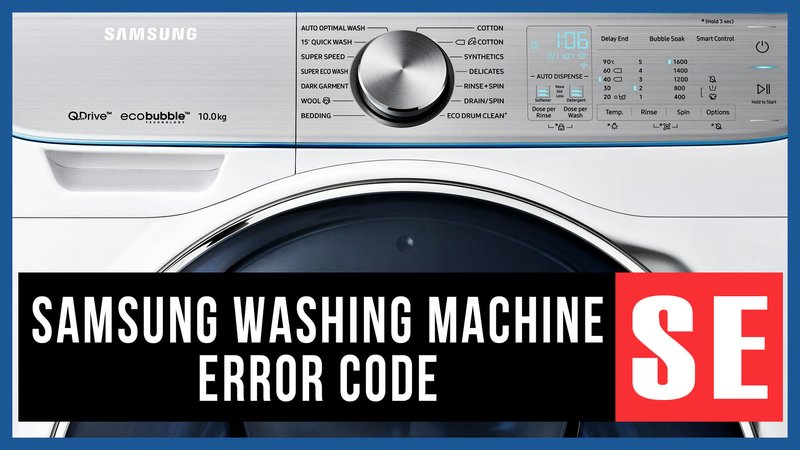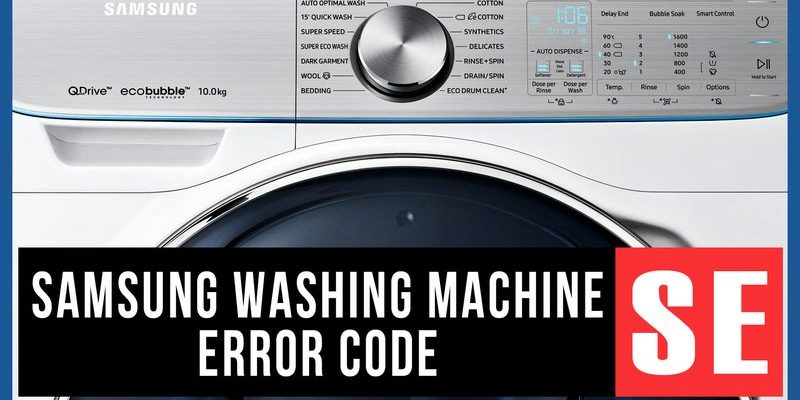
The SE error code on your Samsung washing machine typically indicates an issue with the drainage system. Just imagine trying to sip a thick milkshake through a straw—if there’s a blockage, nothing’s going to come through. Similarly, if there’s a draining problem, your washing machine can’t empty out the water properly. This can lead to a range of issues from wet, soggy clothes to a complete cycle stoppage. Don’t worry, though! Once you know the common causes, you’ll be well-equipped to resolve them and get your washer back to its smooth, humming self.
Understanding the Drainage System
Before we jump into the specific causes of the SE error code, it helps to understand how the drainage system works in your washing machine. When your washer finishes cleaning, it needs to drain all that dirty water. It uses a pump to push the water out into your home’s drainage system, sort of like how you’d use a squirt gun to shoot water out. This pump relies on a series of hoses and filters to do its job efficiently.
Inside your washer, the drain pump kicks in at a designated time during the wash cycle and moves the water into a drain hose, which then carries it away. If any part of this complex yet fascinating system gets clogged or stops working, it can result in an error code like SE. Understanding this mini-water network can shed light on why things might go awry when the SE code shows up.
Common Culprits: Blocked Drain Hose and Filter
One of the most common causes of the SE error code is a blocked drain hose or filter. Imagine the drain hose like a garden hose; if it’s kinked or clogged, water won’t flow smoothly. Over time, bits of fabric, coins, or even detergent residue can build up and create a blockage. If the water can’t exit the machine, the sensor detects it, and voilà, there’s your SE error.
The filter, on the other hand, acts like a net catching small objects which might accidentally get tossed in with your laundry. If only life could catch our little mistakes as easily! But when the filter is full, it can’t do its job properly, so water flow slows down or stops altogether, triggering that pesky error code.
To fix this, you can check both the hose and the filter. Make sure the hose isn’t twisted or clogged, and clean out the filter regularly. Doing so not only helps clear the error code but can prevent it from happening again. It’s like tidying up a messy desk—once it’s done, everything just works better.
Faulty Drain Pump
Another reason you might see the SE error code is because of a faulty or broken drain pump. Think of the pump as the hero of your machine’s drainage story; without it, the water’s not going anywhere. If the pump fails, it can’t push the water out, leading to that error code flashing on your machine’s display.
Sometimes, the pump might not be totally broken but could just be jammed with some small debris. In such cases, it may still hum or make noises, trying its best, but ultimately failing to perform the job it’s meant for. Other times, it might have burned out completely and needs replacing.
When facing pump issues, first, check for any obstructions. If there’s none and the pump still doesn’t operate, you might need a professional’s help to replace it. Like a trusty mechanic, they can ensure everything is up and running again smoothly.
Electrical or Sensor Issues
Sometimes, it’s not a physical blockage causing the SE error, but rather an electrical issue. Washing machines today are quite smart, filled with sensors and electronic controls. If a sensor malfunctions, it can falsely signal an error code like SE. It’s a bit like your phone thinking it’s low on battery when it’s not.
Electrical connections can become loose over time due to the machine’s vibrations. These loose connections can mess up the signals the sensors send to your washer’s brain. Checking these connections can sometimes resolve the error. Just as you might jiggle a loose wire to get a lamp to work, tightening these connections can often solve the issue.
Preventative Maintenance Tips
To prevent the SE error from becoming a regular guest in your laundry room, regular maintenance is key. Just like you wouldn’t allow your car to go without an oil change, keeping your washing machine in top shape requires some upkeep. Start by cleaning the filter every few weeks to ensure it’s free from any lint or debris. This simple act can save you loads of hassle down the line.
Make sure the drain hose isn’t kinked or clogged. A few minutes every month inspecting the hose can prevent blockage buildup. And, if you notice anything unusual about your washing machine’s drainage, address it sooner rather than later. Think of it as a leaky faucet—fixing it quickly prevents bigger problems.
Lastly, don’t hesitate to call in professional help when needed. A little expert advice can be invaluable and keep your washer spinning smoothly. Keeping these tips in mind can help you avoid that SE error for good, leaving you with one less laundry headache.
